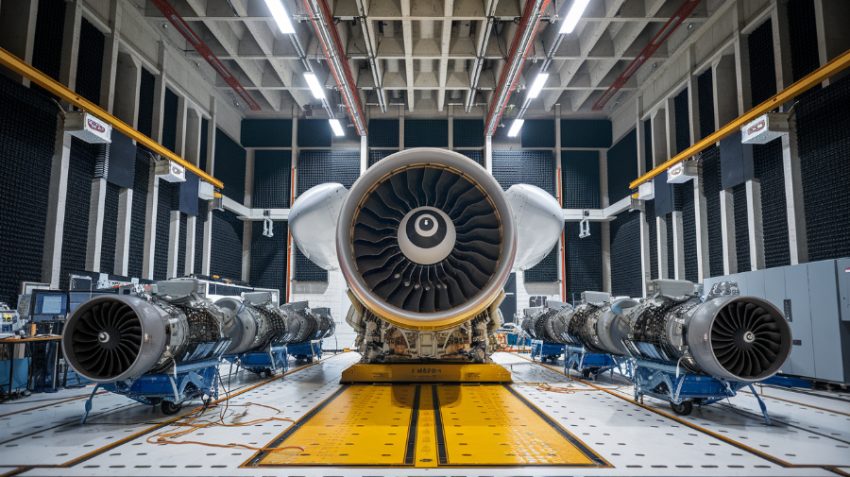The Aircraft Engine Test Cells Market is experiencing notable growth, driven by advancements in aviation technology and a surge in demand for reliable and efficient engine testing facilities. Estimated to grow from USD 3.3 billion in 2023 to USD 4.1 billion by 2028 at a CAGR of 4.2%, this market is pivotal for ensuring the safety, reliability, and efficiency of aircraft engines across commercial and military sectors.
What Are Aircraft Engine Test Cells?
Aircraft engine test cells are specialized facilities designed to test and evaluate aircraft engines under controlled conditions. These test cells:
- Simulate real-world flight conditions.
- Measure critical engine parameters, including thrust, fuel consumption, and vibration.
- Ensure engines meet stringent safety and performance standards before deployment.
Test cells encompass various systems such as data acquisition systems, control units, and advanced instrumentation to provide accurate and reliable engine performance insights.
How Do Aircraft Engine Test Cells Work?
Aircraft engine test cells operate by replicating flight environments to test engine capabilities. Here’s a breakdown of their operation:
1. Engine Setup
The engine is securely mounted within the test cell using specialized fixtures.
2. Simulation and Testing
- Environmental Conditions: Test cells simulate various conditions, such as altitude, temperature, and wind speed.
- Performance Metrics: Parameters like thrust, fuel efficiency, and vibration are monitored.
3. Data Acquisition and Analysis
Sophisticated data acquisition systems collect real-time performance data. Engineers analyze this data to ensure the engine adheres to regulatory and safety standards.
4. Maintenance and Calibration
Routine calibration of sensors and inspection of systems ensure the accuracy and safety of test operations.
Download PDF Brochure: https://www.marketsandmarkets.com/pdfdownloadNew.asp?id=69778185
Market Growth Drivers for Aircraft Engine Test Cells
1. Rising Demand for Commercial Aircraft
- Increasing air travel and globalization are fueling the demand for fuel-efficient aircraft.
- Airlines are upgrading fleets with advanced engines like the Rolls-Royce Trent XWB and General Electric GEnx.
2. Military Modernization
- Military forces worldwide are upgrading to next-generation aircraft like the F-35 Lightning II, increasing the demand for engine test cells.
- UAVs, such as the MQ-9 Reaper, also contribute to this growth.
3. Focus on Maintenance, Repair, and Overhaul (MRO)
- MRO services are critical for extending the lifespan of engines, driving the need for advanced test cell solutions.
Opportunities in the Aircraft Engine Test Cells Industry
1. Advancements in Engine Technology
- Innovations in hybrid and turbo-electric engines create new testing requirements.
- Projects like NASA’s HyTEC emphasize efficiency and sustainability, offering growth potential for test cell solutions.
2. Emerging Markets in Asia-Pacific
- The region’s booming aviation sector and investments in infrastructure provide a fertile ground for market expansion.
3. Retrofit and Upgrades
- Upgrading existing test cells with modern technologies is a cost-effective solution for extending their utility.
Ask for Sample Report: https://www.marketsandmarkets.com/requestsampleNew.asp?id=69778185
Challenges in the Aircraft Engine Test Cells Market
1. High Capital Investment
- Developing advanced test cells requires significant financial and technical resources.
2. Skilled Workforce Shortage
- The aviation industry faces a labor gap due to retiring professionals and a lack of new entrants.
Key Players in the Aircraft Engine Test Cells Market
Prominent Key Companies driving innovation and growth in the Aircraft Engine Test Cells Market include:
- Safran (France): Renowned for advanced engine testing solutions.
- MDS Aero Support Corporation (US): Specializes in custom test cell design.
- Calspan Corporation (US): Focuses on research and development in engine testing.
- Atec, Inc. (US): Offers tailored solutions for military and commercial sectors.
- CEL (Canada): Known for high-quality test cell manufacturing.
Recent Developments
-
GE Aerospace’s Investment in Brazil
- A USD 50 million investment in a state-of-the-art test cell facility highlights the industry’s focus on innovation.
-
NASA’s HyTEC Initiative
- Collaborative efforts with GE and Pratt & Whitney aim to develop efficient, small-core engines.
-
Asia-Pacific Expansion
- Significant investments in aviation infrastructure underscore the region’s growing importance.
Regional Insights
- North America: A mature market with significant investments in advanced test cells.
- Asia-Pacific: Fastest-growing region, driven by rising air travel and government support.
- Europe: Focus on sustainability and modernization propels growth.
FAQs About the Aircraft Engine Test Cells Market
1. What is the current size of the Aircraft Engine Test Cells Market?
The market size is estimated at USD 3.3 billion in 2023.
2. Which region has the highest growth potential?
Asia-Pacific is projected to grow at the highest CAGR during the forecast period.
3. Who are the major players in this market?
Key players include Safran, MDS Aero Support Corporation, and Atec, Inc.
4. What are the main challenges in the market?
High capital investment and skilled workforce shortages are significant challenges.
5. How are advancements in engine technology impacting the market?
Innovations in hybrid and small-core engines are creating new testing requirements and opportunities.
To Gain Deeper Insights Into This Dynamic Market, Speak to Our Analyst Here: https://www.marketsandmarkets.com/speaktoanalystNew.asp?id=69778185
Key Takeaways
- The Aircraft Engine Test Cells Market Size is projected to reach USD 4.1 billion by 2028.
- Growing demand for commercial and military aircraft is a key driver.
- Innovations in engine technology present significant opportunities.
- High capital investment and workforce shortages pose challenges.
- Asia-Pacific emerges as a dynamic growth region.
The Aircraft Engine Test Cells Market is poised for robust growth, underpinned by technological advancements and an increasing focus on efficiency and safety. As the aviation industry evolves, the role of reliable engine testing facilities will become ever more critical, ensuring a safer and more sustainable future for global aviation.

